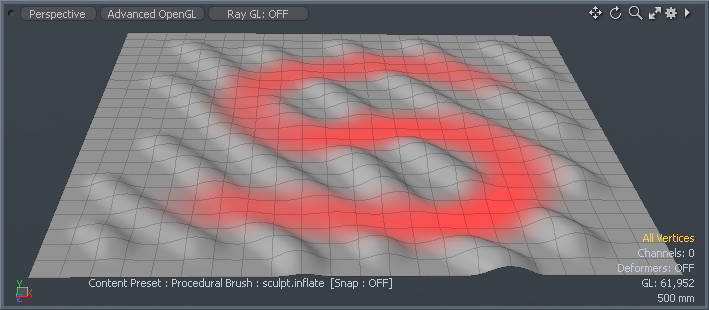
Masking can be used in MODO to limit sculpting to only specific areas of a surface (think of them as sculpting shields). These areas can be defined easily by using the same brush based metaphor used for other MODO painting functions. When brushing over the surface with the Mask tools, the masked areas will change to a bright red color denoting their masked state - these areas cannot be sculpted on until the mask is erased or cleared. Masks are not simply on or off, but can fade across the surface providing a soft border between the masked and sculpted areas. Specific tools are available to control how soft or hard edged the masks are when creating them.
Usage
Masking is applied using the Mask brushes located in the 'Sculpt Tools' subtab of the toolbox in the 'Paint and Sculpt' interface. Masking is only compatible with Multiresolution sculpting in MODO. This requires that the mesh be in Catmull Clark subdivision mode and have the 'Multiresolution' option enabled. For more information on how to set up Multiresolution meshes for sculpting please reference that section of the documentation. Masking can be applied at any point in time when sculpting -it can be applied prior to sculpting to keep certain areas from being affected, or it can be applied to sculpted areas shielding them from, for instance, high frequency surface details being added.
To create a mask, locate the masking tool icons in the toolbox and LMB click the 'Paint' tool to activate. RMB+clicking and dragging directly in the 3D viewport will set the brush size and then LMB+clicking and dragging over the target surface will begin to create the mask, drawing a bright red color on the surface. The red coloring will temporarily overwrite any texturing applied to the surface, but thats OK, the color will come back when the mask is removed. Mask tools also respond to pressure sensitivity when applied using an appropriate tablet input. Once the mask is created as desired pressing 'q' will drop the current tool. Now any of the sculpting tools can be selected and applied to the target surface. Masked areas will remain unaffected by sculpting until the mask itself is modified, disabled or cleared. Masks can be easily cleared using the 'Clear Mask' button under the toolbox. There are also toggle options in the toolbox that allow the mask to be temporarily 'Disabled', 'Inverted' and an adjustment for the opacity of the mask visualization. Overall visibility of Masks can be controlled per viewport using the Viewport options popup, available by clicking the gear icon in the upper right hand corner. Toggle the 'Psub Mask' option under the 'Active Mesh subtab to change their visibility.
While sculpting masks are incredibly convenient and simple to apply, there are some details users should note with their use. The resolution of the mask itself is determined by the subdivision level of the target surface. Also, sculpting masks are not saved with the mesh, only one mask is available at any time and they cannot be saved separately. If you wish to create a mask that can be saved, it is recommended to use a Falloff. Sculpting tools also adhere to the application of Falloffs. While they also cannot be saved directly, the Vertex Map or Image based Falloffs are derived from sources that can be saved.
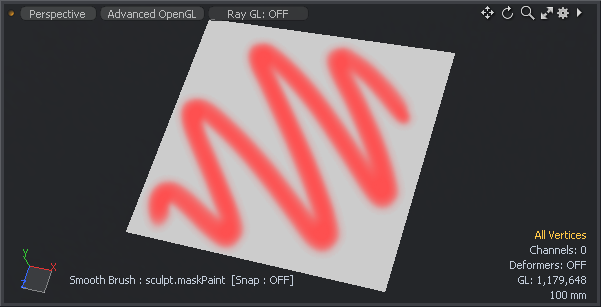
The Mask Paint tool works to add masking to the target surface. The way the mask is added is determined by the brush Tip. The masking tools can also be combined with the Ink and Nozzle options for further customization of the brush strokes. While the tool is active, users can RMB+click and drag in the 3D viewport to set the overall size of the brush. LMB+clicking and dragging over the target surface will paint the mask into the surface additively for each stroke. Pressing and holding 'Ctrl' while stroking over the surface will invert the brush's affect, essentially acting like and eraser.
![]() Value: The 'Value' option determines the strength of the mask applied. When combine with a pressure sensitive pen and tablet, this option determines the maximum strength.
Value: The 'Value' option determines the strength of the mask applied. When combine with a pressure sensitive pen and tablet, this option determines the maximum strength.
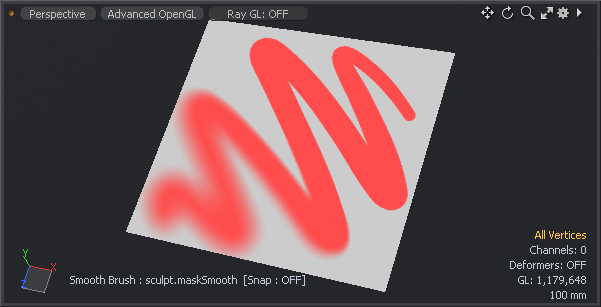
The Mask Smooth tool works to soften or blur an existing mask. How the blur is applied to the mask is determined by the brush Tip. The masking tools can also be combined with the Ink and Nozzle options for further customization of the brush strokes. While the tool is active, users can RMB+click and drag in the 3D viewport to set the overall size of the brush. LMB+clicking and dragging over the target surface will soften mask getting softer for each additional stroke.
![]() Smooth Amount: The 'Smooth Amount' option determines the strength of the blurring effect on the mask.
Smooth Amount: The 'Smooth Amount' option determines the strength of the blurring effect on the mask.
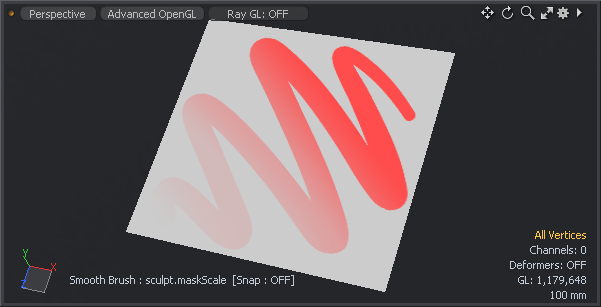
The Mask Scale Down tool works to decrease the strength of the target mask. How the Scale effect is applied to the mask is determined by the brush Tip. The masking tools can also be combined with the Ink and Nozzle options for further customization of the brush strokes. While the tool is active, users can RMB+click and drag in the 3D viewport to set the overall size of the brush. LMB+clicking and dragging over the target surface will decrease the strength of the mask getting weaker with each additional stroke. Pressing and holding 'Ctrl' while stroking over the surface will invert the brush's affect, acting to strengthen or increase the masks affect.
![]() Scale Amount: The 'Scale Amount' option determines how quickly the values are scaled, which is essentially the overall strength of the scaling effect.
Scale Amount: The 'Scale Amount' option determines how quickly the values are scaled, which is essentially the overall strength of the scaling effect.
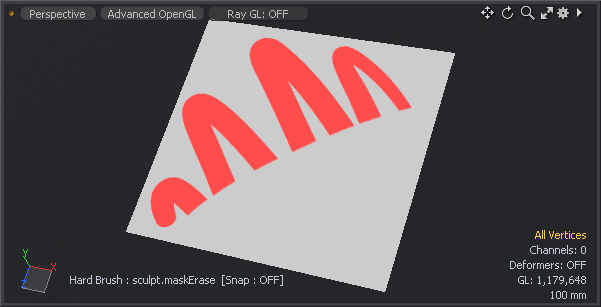
The Mask Erase tool works to completely remove masking from the target surface. While the tool is active, users can RMB+click and drag in the 3D viewport to set the overall size of the brush. LMB+clicking and dragging over the target surface will erase the mask from the surface. Pressing and holding 'Ctrl' while stroking over the surface will invert the brush's affect, essentially acting like the Set Value brush. (Mask Erase has no options panel)
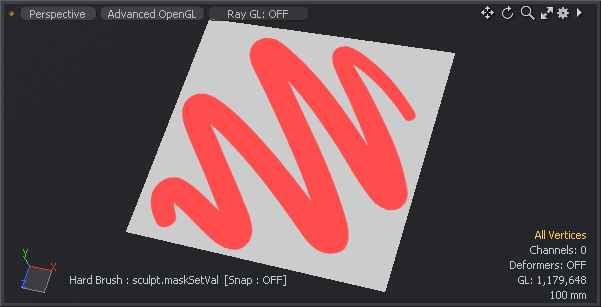
The Mask Set Value tool applies the defined value to the mask overwriting all existing values creating a hard edged solid strokes. The Set Value tool can also be combined with the Nozzle option to customize the brush strokes. While the tool is active, users can RMB+click and drag in the 3D viewport to set the overall size of the brush. LMB+clicking and dragging over the target surface will apply the mask value to the target surface. Pressing and holding 'Ctrl' while stroking over the surface will remove mask values essentially acting like the Eraser.
![]() Value: The 'Value' option determines the strength of the mask applied to the surface.
Value: The 'Value' option determines the strength of the mask applied to the surface.
Masking Controls--
Directly under the masking tools in the Sculpting toolbox, are a number of convenience controls related to the sculpting masks.
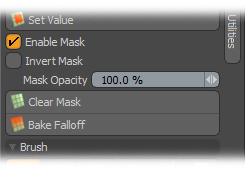
Enable Mask: This toggle option allows users to temporarily disable a mask without having to clear or remove the mask. This way the mask can be used at a later time during the same sculpting session (Masks are not saved with the model or scene). When checked the mask will be active, when unchecked, the mask will be inactive (but still visible).
Invert Mask: This toggle option inverts the affect of the mask (but not its viewport representation).
Mask Opacity: The 'Mask Opacity' control allows users to adjust the strength of the visible representation in the 3D viewport. This doesn't affect the mask strength itself, but only changes how it is viewed.
Clear Mask: To quickly clear a mask from a surface press this button, completely removing all masking values from the surface.
Bake Falloff: The 'Bake Falloff' option allows users to convert any active 'Falloff' into a sculpting mask. With any 'Falloff' active, pressing the "Bake Falloff" button the following dialog opens-

Bake To: Users can select from either 'Mask' merging the current Falloff into the current sculpting mask, or 'Displacement' which will use the Falloff as a means to displace (offset) the current surface.
Displacement Offset: When the 'Bake To' option is 'Displacement' the 'Displacement Offset' option controls the maximum amount of displacement at 100% values for the Falloff.


